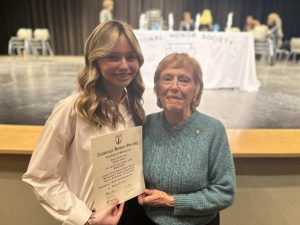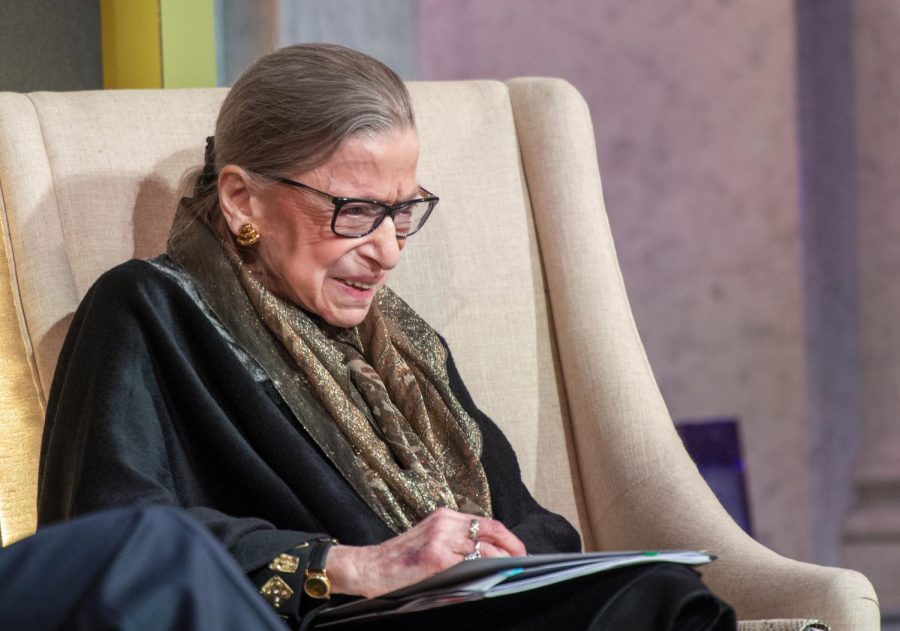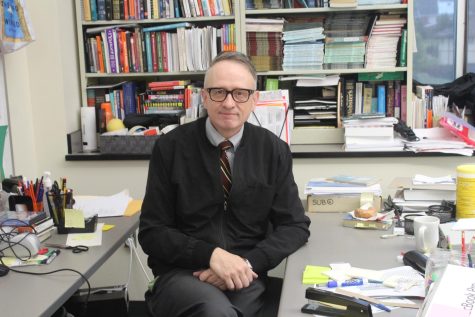The Legacy of Ruth Bader Ginsburg
LBJ Library via Flickr, cc (https://www.flickr.com/photos/lbjlibrarynow/49469498388/)
U. S. Supreme Court Justice Ruth Bader Ginsburg and LBJ Foundation President and CEO Mark K. Updegrove discuss the justice’s trailblazing career at the Library of Congress in Washington, D.C., on Jan. 30, 2020. The LBJ Foundation presented Justice Ginsburg with the LBJ Liberty & Justice for All Award, which honors those who carry on President Lyndon Baines Johnson’s legacy to right wrongs, champion justice, and serve humanity. (LBJ Foundation Photo/Jay Godwin)
While the nation mourns over the loss of Supreme Court Justice Ruth Bader Ginsburg, many are debating on how and when she should be replaced. But it’s time to look beyond that and focus on her upbringing, accomplishments, and truly inspiring life as a whole.
Born Ruth Joan Bader in 1933 to a lower middle-class family in Brooklyn, NY, she never let societal norms against women hold her back. Graduating at the top of her class from James Madison High School, she earned a full-ride scholarship to Cornell University. There she met a young boy who would become the love of her life, Martin Ginsburg. In 1954, she graduated from Cornell and married Ginsburg a year later.
The first years of their marriage were quite difficult, as Martin was drafted into the military in 1954, after the birth of their first child, Jane. He returned from service two years later, followed by Ginsberg’s enrollment into Harvard Law School.
At Harvard, Ginsberg was fighting an uphill battle, as she was only one of eight women in her class of 500. The men there would often harass Ginsberg, but she didn’t let this get in the way of her goals. The school’s dean often rebuked the women for “taking the spots of qualified men.” Ginsberg silenced these denouncements by excelling academically and became the first female to write for the exclusive and prestigious Harvard Law Review.
The family began to face more hardships, as Martin contracted testicular cancer in 1956. This was especially difficult for Ginsberg because she had to care for their daughter, attend class, and take notes for her husband’s classes at Harvard Law. Luckily, Martin recovered two years later. He graduated from Harvard that same year and received a job from a New York City law firm. Ginsberg transferred to Columbia University in N.Y. to be with her family. She graduated first in her class in 1959.
Despite being incredibly intelligent and having an outstanding academic record, she continued to suffer from gender discrimination while seeking employment. After clerking for U.S. District Judge Edmund L. Palmieri, she took up a teaching position at Rutgers University (1963-72) and Columbia University (1972-80), where she originally had graduated from.
Ginsberg believed that the laws in place were “gender-blind” and favored men more than they benefited women. During the 1970s, she served as the director of the Women’s Rights Project at the American Civil Liberties Union (ACLU), for which she argued six landmark cases on gender equality and women’s rights to the Supreme Court.
In 1980, President Jimmy Carter appointed Ginsberg to the U.S. Court of Appeals for the District of Columbia. Here she served until 1993 when President Bill Clinton appointed her to the United States Supreme Court. She filled the seat vacated by Justice Byron White’s death. President Clinton, a Democrat, wanted to balance the fairly conservative Supreme Court with the free-thinking, and progressive Ginsberg. Being approved by the Senate 97-3, she became the Supreme Court’s second female Justice in history.
In 1996, Ginsberg wrote the Court’s decision in the United States v. Virginia case, ruling that the Virginia Military Institute cannot deny women’s admissions. She would later win the American Bar Association’s Thurgood Marshall Award in 1999. She gained unpopular attention for her dissenting opinion in the Bush v. Gore case, which decided the outcome of the 2000 presidential election between George W. Bush and Al Gore. Here she was criticized for simply saying, “I dissent,” instead of the commonly used “I respectfully dissent,” in the Supreme Court.
In June of 2010, Martin Ginsberg died of cancer. Being married for 56 years, this loss was devastating to Ginsberg, but she continued to persevere.
However, on Sept. 18, 2020, Supreme Court Justice Ruth Bader Ginsberg died due to complications with pancreatic cancer. Justice Ginsberg’s story is inspiring like no other. She never stopped working her hardest to make it in a society dominated by men. She never stopped fighting for women’s rights. And even in the darkest of times, she persevered like no other woman before her.

In his second year working in the newspaper, junior Jack Edner brings a special set of skills to the table. When he's not pitching for the varsity baseball...





















